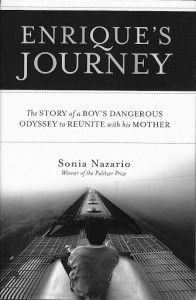Acclaimed journalist Sonia Nazario captivated her Elkins audience Wednesday as the latest speaker in the Seaver Dean’s Distinguished Lecture Series. In an address focusing on her most recent book “Enrique’s Journey,” Nazario described her experiences researching the hardships that face Latin Americans who immigrate to the U.S.
The work, which won the Pulitzer Prize in 2003 for feature writing, tells the story of a teenage Honduran boy’s perilous attempt to rejoin his mother years after she leaves him to find a better life north of the border. Nazario also provided her audience with the broader context of her work writing on social issues for the Wall Street Journal and the Los Angeles Times. In addition, she offered her assessment of the problems at the root of America’s immigration concerns and her solutions.
At the heart of Nazario’s work covering Latin American issues is her own background. The daughter of immigrants, Nazario spent her childhood in Buenos Aires, Argentina, until her family moved to Kansas. Missing the old lifestyle, her parents decided to move the family back to Buenos Aires when Nazario was a teenager. These years happened to be those of the “Dirty War,” a period of time when the military “disappeared” thousands of innocent civilians.
Nazario described the moment at 14 years old when she was inspired to pursue what later became her life passion. Upon seeing blood spattered on the ground, she asked her mother whose it was. Her mother told her that it was the blood of journalists who had dared to speak out against the injustice of the violence. From this moment, Nazario was set on being a journalist.
“I wanted to tell stories that would matter in some way,” she said.
Upon returning to the U.S., Nazario focused her reporting on the poor, the hungry, the Latino community and others facing hardship in their lives. Her initial inspiration for “Enrique’s Journey” was a conversation with her house cleaner, Carmen, a Guatemalan woman who had left her four children in her home country to work in the U.S. and send them money. “It made me wonder: What must it take to make a mother leave her own children?” Nazario said.
the U.S., Nazario focused her reporting on the poor, the hungry, the Latino community and others facing hardship in their lives. Her initial inspiration for “Enrique’s Journey” was a conversation with her house cleaner, Carmen, a Guatemalan woman who had left her four children in her home country to work in the U.S. and send them money. “It made me wonder: What must it take to make a mother leave her own children?” Nazario said.
The ensuing series Nazario wrote for the Los Angeles Times centered on the phenomenon she discovered in pursuit of the answer. Many mothers in extremely poor Latin American countries leave their children in order to work in the U.S., hoping to escape the grinding hand-to-mouth existence they face at home and to provide more food and clothing for their children. Furthermore, although these women generally expect to return home within two years, their stay in the U.S. tends to grow to 5 or 10 years as they struggle to save sufficient funds to return. Many children left behind conclude that their mothers will never come back and attempt to seek them out in the U.S. These children face a harrowing journey through Mexico that, in the words of Nazario, makes traversing the U.S. border itself look like “a cakewalk.” As part of her research for “Enrique’s Journey,” Nazario actually traveled twice the journey through Mexico that is undertaken by such children, witnessing and sometimes experiencing the many dangers that they encounter.
She acknowledged these Latinos’ true need to improve their economic opportunities and their contribution to the U.S. economy by working jobs that most Americans are unwilling to fill. However, in the final minutes of her presentation, Nazario also described some elements of the immigration patterns into the U.S. that she sees as detrimental: that immigrant families tend to pay fewer taxes than the cost of the public services they use. In addition, Latin American children are devastated by the departure of parents who seek work in the U.S.
“[Migrant mothers] are losing the very thing most important – the love of their children,” Nazario said.
Nazario said that instead of increasing border control as the U.S. has unsuccessfully attempted to do in recent decades, the best solution would be to aid Latin American communities to rebuild their own economies through micro-lending, smart trade policy, and support of education and democratic governments.
